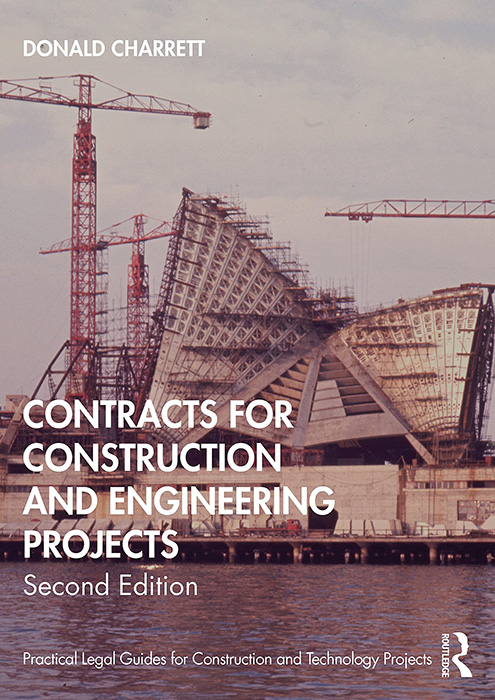Construction Law International – June 2022 – Book Review
Monday 27 June 2022

Contracts for Construction and Engineering Projects
By Donald Charrett
Published by: Informa Law
ISBN: 978-1-032-07383-5 (hardcover or ebook)
546 pages, £150
Publication date: 23 December 2021
Reviewed by Wayne Jocic,
Melbourne Law School
wjocic@unimelb.edu.au
This book is the second edition of a collection of essays on the role of contracts in construction and engineering projects. Suitable, perhaps, for a short train trip? Be warned. You may well miss your station.
This revised, updated and expanded book is a work of great insight. It could only have been written by an author with a lifetime in engineering and the law, and an international perspective. Readers of all levels of experience will be enriched by this book. I had previously read some of the papers and made suggestions on a partial draft of this book. Despite this familiarity with the material, I found myself highlighting sentences, dog-earing pages and muttering in support (and occasional, hesitant disagreement).
It may help to describe the scope of the book before saying more about its quality.
The book consists of 37 chapters stretching to 546 pages. The chapters have been carefully sequenced into five parts:
• Part 1: The Engineer and the Contract (nine chapters, including several on design risk);
• Part 2: The Project and the Contract (13 chapters illuminated by case studies from Australia, Canada, New Zealand, Scotland and beyond);
• Part 3: Avoidance and Resolution of Disputes (seven up-to the-minute chapters, including one on construction disputes after Covid-19, two covering the 2017 FIDIC suite, and commentary on the Singapore Convention);
• Part 4: Forensic Engineers and Expert Witnesses (four chapters, with an especially helpful seven-page table comparing the requirements for expert evidence in Australia, England and Wales, and Singapore); and
• Part 5: International Construction Contracts (three chapters, culminating in ‘final comments’ that warrant the rare luxury of a second read).
The hardcover book is attractive and well-structured. The ebook is easy to navigate, thanks to an expansive table of contents and helpful but unobtrusive hyperlinks. Both benefit from 15 tables, a helpful glossary and a reliable index. A particularly charming feature of the book is the emphasis it places on case studies from around the world, including the Scottish Parliament House, the Sydney Opera House and the Quebec Bridge. More than 30 illustrations accompany these case studies.
The scope of the book is clearly impressive, but why is it worth reading? Charrett modestly describes the book as ‘a collection of papers written on a variety of topics, at different times, and for a variety of audiences’ (page 525). This might suggest a hotchpotch of unconnected, outdated papers. The opposite is true.
The book is unified in a way that Wittgenstein describes best: ‘the strength of the thread does not reside in the fact that some one fibre runs through its whole length, but in the overlapping of many fibres’.1 These unifying fibres include the parties’ expectations about time, cost and quality; the role of the contract as a charter of risk but also as a contract management manual; the special significance of design; and the geographic and temporal universality of most construction problems. The result is a book that can easily be read in standalone chapters, but which nonetheless forms a coherent narrative.
The book is current in three senses. First, much of the material is timeless, particularly in Part 2, where Charrett’s analysis of troubled projects will prompt readers to draw parallels with their own experience.
Second, where law, commercial practice or risks have evolved, the book features new or revised chapters. The obvious example is the Covid-19 pandemic. One new chapter concerns the impact of Covid-19 on construction contracts. Another is devoted to the pandemic’s implications for construction disputes. The index references Covid-19 more than 20 times. One further example of the currency of the book is its focus on the 2017 editions of the FIDIC suite of contracts.
Finally, the book is not only current but prophetic. Chapter 35 is titled ‘Lex Constructionis — or my country’s rules?’. It extrapolates from the basic principles of freedom of contract and enforcement of bargains to universal principles of construction law. Charrett proposes 20 such principles designed to ‘encourage projects that provide better value for money and promote international trade and greater comity between nations whilst fulfilling the parties’ legitimate expectations’ (page 499).
Thoughtful construction lawyers around the world would do well to buy this book, read it and debate its central themes.
1 Ludwig Wittgenstein, Philosophical Investigations (G E M Anscombe translation, 3rd ed, Basil Blackwell, 1963) 67.
